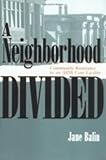A Neighborhood Divided : Community Resistance to an AIDS Care Facility / Jane Balin.
Material type: TextSeries: The Anthropology of Contemporary IssuesPublisher: Ithaca, NY : Cornell University Press, [2018]Copyright date: ©1999Description: 1 online resource (192 p.)Content type:
TextSeries: The Anthropology of Contemporary IssuesPublisher: Ithaca, NY : Cornell University Press, [2018]Copyright date: ©1999Description: 1 online resource (192 p.)Content type: - 9781501720826
- 362.1/969792056 23
- online - DeGruyter
| Item type | Current library | Call number | URL | Status | Notes | Barcode | |
|---|---|---|---|---|---|---|---|
 eBook
eBook
|
Biblioteca "Angelicum" Pont. Univ. S.Tommaso d'Aquino Nuvola online | online - DeGruyter (Browse shelf(Opens below)) | Online access | Not for loan (Accesso limitato) | Accesso per gli utenti autorizzati / Access for authorized users | (dgr)9781501720826 |
Frontmatter -- Contents -- Acknowledgments -- 1. The Neighborhood and the Sociologist -- 2. West Highland: From a Colonial Village to an Urban Middle-Class Neighborhood -- 3. AIDS Moves into the Neighborhood -- 4. Taking Sides -- 5. Status Group Conflicts, Symbols, and Politics -- 6. The Sounds of Silence -- 7. AIDS and Community: Some Policy Proposals and Conclusions -- Index
restricted access online access with authorization star
http://purl.org/coar/access_right/c_16ec
When a nursing facility for AIDS patients is planned for a city neighborhood, residents might be expected to respond, "Not in my backyard." But, as Jane Balin recounts in A Neighborhood Divided, when that community is known for its racial and ethnic diversity and liberal attitudes, public reaction becomes less predictable and in many ways more important to comprehend.An ethnographer who spent two years talking with inhabitants of a progressive neighborhood facing this prospect, Jane Balin demonstrates that the controversy divided residents in surprising ways. She discovered that those most strongly opposed to the facility lived furthest away, that families with young children were evenly represented in the two camps, and that African Americans followed a Jewish community leader in opposing the home while dismissing their own minister's support of it. By viewing each side sympathetically and allowing participants to express their true feelings about AIDS, the author invites readers to recognize their own anxieties over this sensitive issue. Balin's insightful work stresses the importance of uncovering the ideologies and fears of middle-class Americans in order to understand the range of responses that AIDS has provoked in our society. Its ethnographic approach expands the parameters of NIMBY research, offering a clearer picture of the multi-faceted anxieties that drive responses to AIDS at both the local and national levels.
Mode of access: Internet via World Wide Web.
In English.
Description based on online resource; title from PDF title page (publisher's Web site, viewed 26. Apr 2024)


